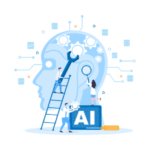How you can use neural nets in your software project to unlock the full potential of data-driven intelligence, creating innovative solutions that delight users and stakeholders alike.

In today’s data-driven world, neural networks are opening new possibilities for software development. These powerful algorithms draw inspiration from the human brain, enabling machines to learn, predict, and solve complex problems.
This article delves into neural networks and explores their applications in software development.
What’s A Neural Network?
Understanding what neural networks are is essential to know how they work. The term ‘neural’ is derived from neurons or nerve cells, the basic functional units of a human or animal’s nervous system. Through machine learning, neural networks mimic the operations of the human brain.
Neural networks are artificial neural networks (ANNs) or simulated neural networks (SNNs). The design and functionality of a neural network draw inspiration from the human brain. The architecture comprises node layers distributed across an input layer, one or multiple hidden layers, and an output layer.
Various neural networks exist, categorized based on the neurons utilized, density, data flow, structure, depth activation filters, and layers. Below is an overview of the diverse types of neural networks:
- Multilayer Perceptron
- Feedforward Neural Network
- Modular Neural Network
- Radial Basis Function Neural Network
- Recurrent Neural Network
- Perceptron
- Modular Neural Network
- Sequence-to-Sequence Models
- Long Short-Term Memory (LSTM)
- Convolutional Neural Network
Using Neural Networks for Software Development

The next step in understanding neural networks is to explore their practical applications. Neural networks’ large, interconnected processing nodes can learn to recognize patterns from input data, making them suitable for various software development tasks.
Enable Speech Recognition
Neural networks are increasingly being used for speech recognition.
Some of the many applications of neural networks in speech recognition include:
- Automatic Speech Recognition: The neural network is trained to recognize speech patterns and convert them into text, which is helpful for voice-to-text applications.
- Speaker Identification: The neural network identifies the speaker based on their voice, used for security applications or identifying people over the phone.
- Speaker Verification: The neural network verifies a person’s identity based on their voice, used for authentication or fraud detection.
Some practical applications of speech recognition using neural networks are:
- Converting clinical discussions in real-time into documentation.
- Automatically categorizing calls and assisting call center agents.
- Correctly subtitling meetings and video recordings for broader content reach.
Facilitate Natural Language Processing

Natural language processing (NLP) refers to the capability of processing natural and human-created text. Neural networks are increasingly being adopted for NLP to help computers extract insights and meaning from documents and text.
Neural networks excel at pattern recognition, making them suitable for processing natural language data.
NLP uses neural networks in the following ways:
- Analyzing business intelligence, such as long-form documents, forms, and emails.
- Automating chatbots and virtual agents.
- Summarizing articles and papers for a specific topic.
Neuronal networks can learn tasks humans find hard or impossible, like translating between languages without knowing them.
In these cases, neural networks can provide high-quality translations that outperform traditional machine translation methods.
Enhance Computer Vision
A computer can understand an image or video through computer vision. Neural networks have emerged as the leading approach to computer vision, as they are exceptionally proficient at identifying patterns and classifying objects in images.
Computer vision tasks have become synonymous with convolutional neural networks (CNNs). These networks excel at image recognition, object detection, and segmentation.
Some practical applications of neural networks in computer vision include:
- Facial recognition for security purposes or social media tagging.
- Medical image analysis to detect diseases or abnormalities.
- Autonomous vehicle navigation and control systems.
- Quality control in manufacturing, detecting defects in production lines.
Improve Recommendation Systems
In today’s digital world, recommendation systems have become essential to e-commerce, content streaming, and social media platforms. Neural networks can be utilized to enhance these systems by improving the accuracy of personalized recommendations.
Users’ browsing history, purchase patterns, and preferences are used to predict their interests using these networks.
Some typical applications of neural networks in recommendation systems include:
- Product recommendations on e-commerce websites.
- Personalized content recommendations on streaming platforms.
- Tailored newsfeeds on social media platforms.
- Job matching and skill assessment on job platforms.
Optimize Data Processing

Data processing is critical in numerous industries, from finance to healthcare. Neural networks can identify patterns and trends even with a lot of data.
Some applications of neural networks in data processing include:
- Fraud detection in banking and finance.
- Predicting equipment failure and maintenance scheduling in manufacturing.
- Analyzing complex weather patterns to produce more accurate forecasts.
- Identifying anomalies in network traffic for cybersecurity purposes.
Integrating Neural Networks Into Your Software Project
After establishing the various uses of neural networks in software development, let’s discuss how to integrate them.
Choose the Right Framework
Selecting an appropriate framework is a critical first step in integrating neural networks into your project. Some popular neural network frameworks include TensorFlow, PyTorch, Keras, and Caffe. To determine the best fit, assessing your project’s requirements and each framework’s capabilities is essential.
Prepare Your Data
Quality data is crucial for the success of your neural network. Ensure that your data is clean, relevant, and representative of the problem you’re trying to solve. To monitor the performance of your neural network, divide your data into training, validation, and test sets.
Train Your Model
After preparing your data, it’s time to train your neural network. This step involves feeding the training data through the network and adjusting the weights and biases of the nodes to minimize the error in the output. This process may take time, depending on the dataset’s size and the neural network’s complexity.
Test and Evaluate Your Model
Use the test set to evaluate your neural network’s performance. By evaluating the network, you will find out whether it generalizes well to new data and if it needs improvement.
Deploy Your Neural Network
After optimizing your neural network, integrate it into your software project. This step may involve creating APIs or building a user interface to interact with the network.
FAQs about how you can use neural nets in your software project
What are the uses of neural networks in software development?
Neural networks are used in various aspects of software development, including speech recognition, natural language processing, face detection, chatbot creation, stock market prediction, fraud detection and prevention, and data modeling.
How do neural networks contribute to modern software technology solutions?
Neural networks enable software solutions to learn from experience, identify patterns, and make predictions, enhancing problem-solving capabilities, improving decision-making, and allowing for more efficient and accurate data processing.
How do you implement a neural net?
Data is collected and preprocessed; the network structure is defined, and the network is trained, evaluated, and fine-tuned to improve performance.
What is an example of using a neural network?
A famous example of using neural networks is speech recognition systems, where neural networks are trained to recognize and convert human speech patterns into text, enabling voice-to-text applications and virtual assistants.
Where can I find neural network projects with source code?
Numerous open-source neural network projects with source code can be found on platforms like GitHub, GitLab, and Bitbucket. Examples include TensorFlow, Keras, and PyTorch.
What are some neural networks projects for beginners?
Beginner-friendly neural network projects include handwriting recognition, sentiment analysis, image classification, and simple chatbot creation.
Where can I find neural-network projects on GitHub?
Searching for “neural network” or specific types of neural networks on GitHub will yield numerous projects and repositories, including popular frameworks like TensorFlow and Keras, and individual projects focused on particular applications.
Where can I find neural network projects with Python source code?
Platforms like GitHub, GitLab, and Bitbucket host numerous Python-based neural network projects, including popular libraries like TensorFlow and PyTorch.
Many tutorials and blog posts contain Python source code.
What are some final-year neural network projects?
Projects can include advanced topics like generative adversarial networks (GANs), reinforcement learning, neural style transfer, or implementing state-of-the-art architectures.
What are some neural network project ideas?
The ideas include emotion recognition, music genre classification, recommender systems, anomaly detection, and autonomous robot navigation.
How are neural networks used in machine learning?
In machine learning, neural networks are powerful algorithms that can learn patterns and relationships from data, enabling classification, regression, clustering, and reinforcement learning tasks.
Where can I find Python-based neural network projects on GitHub?
Searching for “neural network Python” or specific types of neural networks on GitHub will yield numerous Python-based projects and repositories, including popular frameworks like TensorFlow, Keras, and PyTorch and individual projects focused on specific applications.
Wrapping up about how you can use neural nets in your software project
Software development has been revolutionized by neural networks.
You can enhance your software project’s capabilities and deliver a more refined, intelligent user experience by understanding neural networks.
Jane Watson is a seasoned expert in AI development and a prominent author for the “Hire AI Developer” blog. With over a decade of experience in the field, Jane has established herself as a leading authority in AI app and website development, as well as AI backend integrations. Her expertise extends to managing dedicated development teams, including AI developers, Machine Learning (ML) specialists, and other supporting roles such as QA and product managers. Jane’s primary focus is on providing professional and experienced English-speaking AI developers to companies in the USA, Canada, and the UK.
Jane’s journey with AI began during her time at Duke University, where she pursued her studies in computer science. Her passion for AI grew exponentially as she delved into the intricacies of the subject. Over the years, she honed her skills and gained invaluable experience working with renowned companies such as Activision and the NSA. These experiences allowed her to master the art of integrating existing systems with AI APIs, solidifying her reputation as a versatile and resourceful AI professional.
Currently residing in the vibrant city of Los Angeles, Jane finds solace in her role as an author and developer. Outside of her professional pursuits, she cherishes the time spent with her two daughters, exploring the beautiful hills surrounding the city. Jane’s dedication to the advancement of AI technology, combined with her wealth of knowledge and experience, makes her an invaluable asset to the “Hire AI Developer” team and a trusted resource for readers seeking insights into the world of AI.







